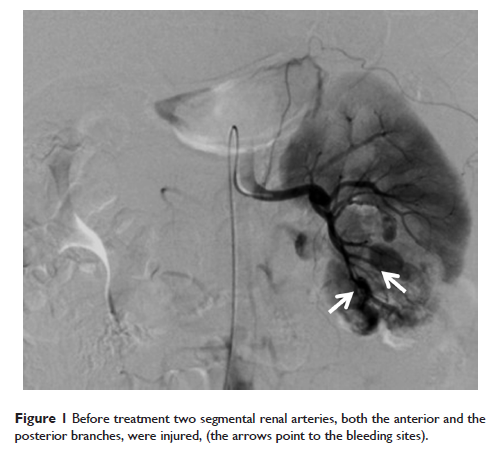9 1 2 3 6
论文已发表
注册即可获取德孚的最新动态
IF 收录期刊
- 2.6 Breast Cancer (Dove Med Press)
- 3.9 Clin Epidemiol
- 3.3 Cancer Manag Res
- 3.9 Infect Drug Resist
- 3.6 Clin Interv Aging
- 4.8 Drug Des Dev Ther
- 2.8 Int J Chronic Obstr
- 8.0 Int J Nanomed
- 2.3 Int J Women's Health
- 3.2 Neuropsych Dis Treat
- 4.0 OncoTargets Ther
- 2.2 Patient Prefer Adher
- 2.8 Ther Clin Risk Manag
- 2.7 J Pain Res
- 3.3 Diabet Metab Synd Ob
- 4.3 Psychol Res Behav Ma
- 3.4 Nat Sci Sleep
- 1.9 Pharmgenomics Pers Med
- 3.5 Risk Manag Healthc Policy
- 4.5 J Inflamm Res
- 2.3 Int J Gen Med
- 4.1 J Hepatocell Carcinoma
- 3.2 J Asthma Allergy
- 2.3 Clin Cosmet Investig Dermatol
- 3.3 J Multidiscip Healthc

已发表论文
超选择经导管肾动脉栓塞治疗用于非医源性钝性肾损伤的出血治疗:来自 16 例病例的临床报告
Authors Rao D, Yu H, Zhu H, Yu K, Hu X, Xie L
Published Date June 2014 Volume 2014:10 Pages 455—458
DOI http://dx.doi.org/10.2147/TCRM.S59671
Received 24 December 2013, Accepted 17 March 2014, Published 16 June 2014
Objective: To explore the therapeutic efficacy and outcome of superselective transcatheter renal artery embolization for the treatment of hemorrhage from non-iatrogenic blunt renal trauma (BRT).
Methods: Sixteen patients who received superselective transcatheter renal artery embolization for non-iatrogenic BRT hemorrhage between January 2003 and December 2012 were reviewed retrospectively. Spring steel coils with gelatin sponge particles were used to embolize branches of the renal artery in 15 patients with injuries to the segmental or distal renal arteries; superselective internal iliac artery branch embolization was used to occlude hemorrhage from the branch of the renal artery in two patients with pelvic fracture complicated with internal iliac artery branch laceration; and balloon catheter occlusion was used to embolize the branch of the renal artery in one patient with renal artery trunk laceration.
Results: Embolization was achieved successfully in a one-stop procedure in all cases. The patient who received balloon catheter occlusion for renal artery trunk laceration was transferred immediately to surgery for emergency nephrectomy. Another patient died of intracranial trauma 1 day after surgery, although macroscopic hematuria disappeared at the time. Macroscopic hematuria disappeared within 1 day after surgery in the other 14 patients. Follow-up visits at times ranging from 6 months to 9 years after the procedure showed normal renal function without evidence of complications in all surviving patients.
Conclusion: Superselective transcatheter renal artery embolization is an effective minimally invasive therapy for the treatment of BRT hemorrhage.
Keywords: blunt renal trauma, superselective cannulation, renal artery embolization
Methods: Sixteen patients who received superselective transcatheter renal artery embolization for non-iatrogenic BRT hemorrhage between January 2003 and December 2012 were reviewed retrospectively. Spring steel coils with gelatin sponge particles were used to embolize branches of the renal artery in 15 patients with injuries to the segmental or distal renal arteries; superselective internal iliac artery branch embolization was used to occlude hemorrhage from the branch of the renal artery in two patients with pelvic fracture complicated with internal iliac artery branch laceration; and balloon catheter occlusion was used to embolize the branch of the renal artery in one patient with renal artery trunk laceration.
Results: Embolization was achieved successfully in a one-stop procedure in all cases. The patient who received balloon catheter occlusion for renal artery trunk laceration was transferred immediately to surgery for emergency nephrectomy. Another patient died of intracranial trauma 1 day after surgery, although macroscopic hematuria disappeared at the time. Macroscopic hematuria disappeared within 1 day after surgery in the other 14 patients. Follow-up visits at times ranging from 6 months to 9 years after the procedure showed normal renal function without evidence of complications in all surviving patients.
Conclusion: Superselective transcatheter renal artery embolization is an effective minimally invasive therapy for the treatment of BRT hemorrhage.
Keywords: blunt renal trauma, superselective cannulation, renal artery embolization
